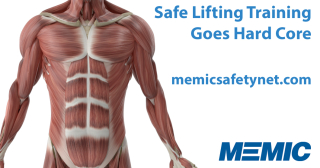Safe Lifting Training Goes Hard Core
MEMIC has long advocated a no-lift program using mechanical devices to control overexertion strains for healthcare workers assisting patients and residents.
The forward lean posture often assumed by caregivers increases the potential for a back injury as a result of the cumulative effect of the micro-trauma placed on the spine and surrounding soft tissue. As an adjunct to a comprehensive safe patient handling program that employs engineering controls, MEMIC's healthcare team promotes the benefits of core muscle conditioning and contraction. Core training has broader implications for all industries where manual material handling is performed and education is provided on safe lifting technique.
There are roughly twenty-nine muscles considered to comprise the core, essentially those that originate and/or insert from the pelvis to the base of the ribs. These muscles can be categorized into the following groups: pelvic floor, lumbar spine, abdominal wall, and hip musculature. Click here to visualize core strengthening exercises with the Mayo Clinic.
The need to condition the core muscles for proper posture and support is revealed by examining the skeleton in relationship to the effect of gravity and load placed on the bony structure. In an upright position, there is the mass of the skull, upper extremity, and rib cage articulating with the spinal column in our mid-section which in turn connects to the mass of the pelvic girdle. A rigid wall of soft tissue to shore up the upper mass of our body is naturally preferred over a weak wall for optimal support.
Proper conditioning and contraction of the core muscles provides for the following:
- Promotes stability of the spine for extremity movement
- Helps to maintain proper posture and center of gravity alignment
- Optimizes movement efficiency throughout the body
For more information on material handling and safe lifting, check out the MEMIC Safety Director resource library.


